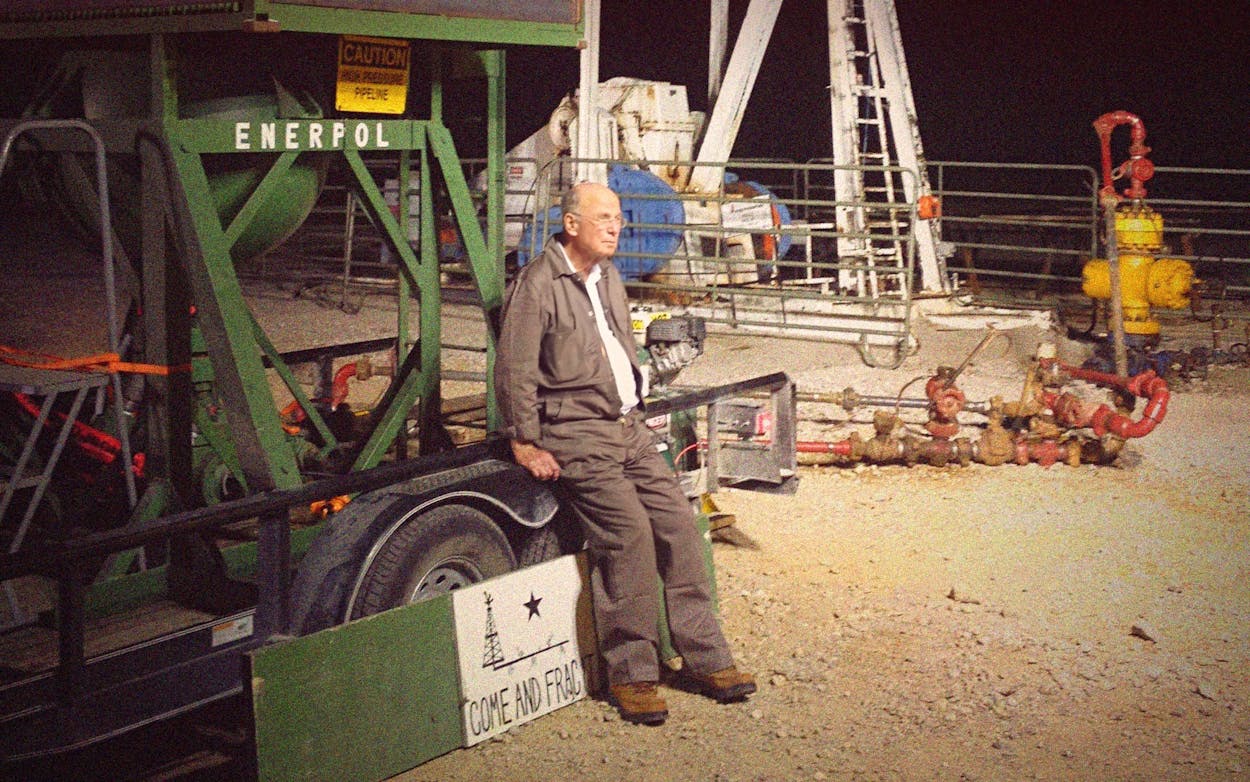I first encountered Claude Cooke on the internet, when he and his wife, Joyce, briefly became viral sensations. In a YouTube clip viewed more than three million times since it was posted, in 2007, they dance down a suburban Houston street to a rap song while their canary-yellow car slowly glides—driverless—between them. “Ghost Ridin’ Grandma” would have been a classic of its genre, if there were a genre of such videos. Cooke was 77 years old at the time and danced with youthful enthusiasm.
The second time I encountered Cooke, he called out of the blue to talk to me about fracking. This was a few years later, amid growing concerns about whether the use of hydraulic fracturing would lead to widespread water contamination. When something went wrong with groundwater, don’t blame the fracking, he advised—look at the cement. “If there is a problem, the issue is well integrity,” he said. It wasn’t until some weeks later that I realized the oil industry elder statesman who spoke to me in the measured sentences of an expert witness was the same guy I’d seen dancing on YouTube.
Cooke is best known for ceramic proppant, a superstrong, specklike sphere that holds open fractures created by fracking. The device, which he invented while working for Exxon in the seventies, allowed the industry to frack deeper, hotter wells. Until Cooke’s innovation, the weight of the earth would often grind up the sands then used to prop open fractures, preventing the natural gas from flowing to the surface. In 2006, a year before his YouTube fame, the Society of Petroleum Engineers unveiled its first class of fracking “legends.” Cooke was one of nine inductees. He died on January 17, at age 94, in his home on Lake Conroe.
Cooke loved the oil industry; it was part of who he was. He was born to a father who worked as a roustabout in an Arkansas oil field, and he graduated from high school amid Kilgore’s derricks. He went on to earn a PhD in physics from the University of Texas and, years later, a law degree at the University of Houston. He spent three decades as an Exxon researcher—studying proppants, fracking, well cementing, and other topics relevant to the oil industry—before pursuing a second career as an intellectual property lawyer with the firm Baker Botts.
On the wall of his office in Conroe hung a black and white photograph of Exxon and Halliburton engineers fracking a well in the Panhandle. At 21,000 feet deep, it was a record setter at the time. Cooke was one of the geniuses at research labs in Houston and Tulsa who helped the industry get better at fracking, until one day in the 2000s, when the obscure oil field technique became ubiquitous. It helped reverse years of declining U.S. energy production, becoming an elixir of youth for aging oil fields such as those in the Permian Basin. The resulting boom came with risks to the climate and environment—and Cooke saw those coming as well.
He was clear-eyed enough to realize that the oil and gas industry had flaws it should face up to, alongside its successes. Even as the world became more polarized, he rejected the notion that someone must be either a full-throated critic of fossil fuels or a steadfast true believer. It’s a lesson he taught me more than a decade ago, and I carry it with me to this day.
In 1979, he invented a technique to address what he saw as a major industry problem: faulty cement. Called radial differential temperature logging, the tool he devised could be lowered into a well to discover cracks in cement that let gas or fluids travel upward, potentially escaping to pollute the surface. (See, for instance, the Deepwater Horizon disaster and the ongoing leaking well in Crane County.)
Unfortunately, the oil industry didn’t much care for Cooke’s invention. Companies proved reluctant to spend money seeking out faults that would require them to pay for costly repairs. Cooke unsuccessfully argued that they’d either pay for such remediation now or face much bigger costs and problems down the road. (Again, look at Deepwater Horizon and Crane County.)
Cooke moved on, continuing to pick up patents the way some collectors amass sports memorabilia. In the 2010s, he started a company with one of his grandsons to market a degradable polymer plug he had patented. It allowed oil companies to bypass the expensive step of removing plugs before a fracked well begins producing; Cooke’s plug degraded by itself. The enterprise was bought by a Japanese energy service company in 2015, and degradable polymer plugs are widely used today in the Permian Basin. Cooke was then in his mid-eighties, still actively thinking about how to make the oil industry more efficient, safer, and better.
Since his passing, I’ve been thinking about the end of that viral YouTube video. After a couple minutes of dancing, Claude turns to his wife. “So, Grandma,” he asks, “you think Luby’s is still open for lunch?” One can only hope it is.








